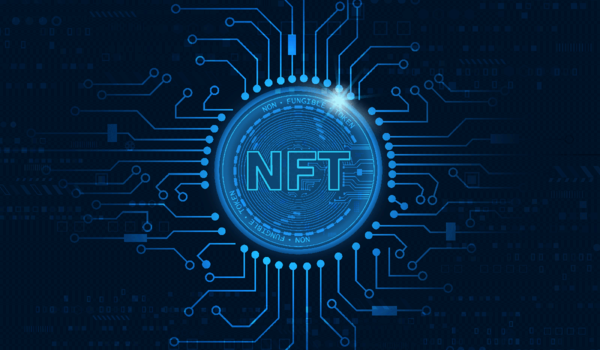Products & Technologies
Back to Menu
Products & Technologies
Services
Resources
Posted
March 28, 2022

Stay updated on our content.
The Tokenization of Everything is Fueling the Data Exponential

Mar 28, 2022
Key Takeaway
In our Battle of Exponentials framework, data grows exponentially as Moore’s Law slows, creating increased demand for silicon and wafer fab equipment. Are there enough valuable applications to fuel data growth as capital intensity rises? We believe so. “Digital transformation” in the form of A.I., IoT and robotic process automation are well established, understood and valued. Behind these applications come technologies like web3, blockchain and tokenization which are still a mystery to many—but will join the list of technologies that transform past practices to digital alternatives that generate substantial economic value. In this blog post I focus on the promise of tokenization.
What is a (Digital) Token?
A token is a cryptographic string of numbers (i.e. data) that identifies a specific record of ownership or right. The object of the token could be nearly anything—a material possession, personal profile information, or a unit of value. A token is associated with the blockchain on which it is recorded. A token can be fungible (interchangeable), or non-fungible (NFT). There can be only one NFT of its kind (e.g., an NFT representing a particular diamond), whereas there can be an unlimited number of fungible tokens (e.g., tokens representing airline frequent flier miles).
Who Needs Tokenization?
Many physical objects can be difficult to trade, and therefore possess limited liquidity. When objects are represented by digital tokens, however, they can be marketed and traded more easily. Tokenization has potential across very large markets: music, real estate, jewelry/collectibles, securities, virtual assets, etc. Collectively, these markets are worth hundreds of trillions of dollars. Virtually all types of trade and transactions can be tokenized.
An important benefit of tokenization is that it reduces friction, making it easier for a person or business to reach customers directly, bypassing layers of intermediaries. Traditional markets feature different types of intermediaries in the form of exchanges, brokers and agents. Intermediaries typically control access to markets and collect fees, which reduce the asset owner’s proceeds.
Power of “Triple-Entry” Accounting
Tokens implement “smart contracts”—electronic versions of traditional contracts. Tokens are recorded on blockchains (e.g., Ethereum). This means every transaction using a token becomes a permanent and immutable record on the blockchain, available for audit on-demand. This is a big improvement over traditional record-keeping—much of which remains paper-based, cumbersome and subject to loss or theft.
Example 1: tokenization of real estate. Propy, a Palo Alto, California-based company, has introduced technology that allows online and “self-driving” real estate transactions using Ethereum smart contracts, which mimic the escrow function. Ownership of property is established through an LLC or Trust, which is then turned into an NFT. The buyer of the NFT receives a claim to the property. Transactions are recorded on the Ethereum blockchain, in addition to being recorded at the county for tax collection purposes.
Example 2: tokenization of identity. Universal Profile provides the LUKSO blockchain network to allow users to set up decentralized profiles for the modern lifestyle industry and creative economies. Profiles can link to assets owned, avatars, digital fashion, personal identity, social profiles, images, as well as other information such as participation in digital projects. Identities on the LUKSO network are self-sovereign, which means that their owners have full control over their digital selves and the data attached to them.
Example 3: tokenization of music. In January 2021, Justin Blau, known as 3LAU, became the first musician to tokenize an album. He sold 33 NFTs attached to the album for a total of $11.6 million. He separately sold one song for $250,000. According to the artist, no record label pays so much.
Example 4: tokenization of screenplays. New York Times bestselling author and screenwriter Ben Mezrich is tokenizing his next screenplay about NFTs and web3 (see Ben Mezrich Project on http://opensea.io). He is building a community over shared interests such that community members are incentivized by owning a piece of the outcome.

Tweet from Ben Mezrich. Source: Twitter
Tokenization of Everything = More Data = More Value = More Silicon
In our proprietary data growth model, data are generated each time a computer communicates an IP (Internet Protocol) packet. The creation of digital tokens, and transactions involving digital tokens, all generate data. Digital transformation in the form of tokenization replaces slow, high-friction transactions—that often require human intermediaries—into quick, digital transactions that enable order-of-magnitude increases in commerce along with greater security and transparency. Just as zero-commission, web-based stock trading platforms (e.g., Robinhood) and fractional share-ownership enable more people to participate in the equity markets, tokenization promises to digitize and democratize virtually all kinds of transactions. It is not a stretch to imagine a future in which every valuable item—tangible or intangible—is tokenized.
In a future blog post, I will discuss how blockchain technologies and decentralized computing will enable web3—another driver of exponential data growth.
Tags: Exponential, Tokenization, Blockchain, NFT, Web3, Ethereum, WFE, WFE Intensity
Sundeep Bajikar
Vice President and Head, Corporate Strategy and Marketing

Sundeep Bajikar is Vice President and Head, Corporate Strategy and Marketing at Applied Materials where he is responsible for shaping Applied’s strategies, including business and financial models related to the future of computing and Net Zero, in addition to tracking and analyzing Applied’s core business performance. He joined Applied in 2017 after spending ten years as a Senior Equity Research Analyst covering global technology stocks including Apple and Samsung Electronics, for Morgan Stanley and Jefferies. Previously he worked for a decade as researcher, ASIC Design Engineer, System Architect and Strategic Planning Manager at Intel Corporation.
He holds an MBA in finance from The Wharton School and M.S. degrees in electrical engineering and mechanical engineering from the University of Minnesota. He holds 13 U.S. and international patents with more than 30 additional patents pending. Sundeep is also author of a book titled, “Equity Research for the Technology Investor – Value Investing in Technology Stocks.”

A New Normal for Semiconductor Growth?
In this blog I illustrate how the semiconductor revenue CAGR has increased in recent years and explain why growth could continue at this higher rate for the foreseeable future.

Battle of Exponentials — A Different Way to Think About Accelerating Semiconductor Growth
Semiconductor growth has accelerated to higher levels that may represent a new normal as suggested by our “battle of exponentials” framework.

Expanding the Ecosystem for Hybrid Bonding Technology
Applied Materials recently entered a new phase of our R&D collaboration with A*STAR’s Institute of Microelectronics to accelerate materials, equipment and process technology solutions for hybrid bonding and other emerging, 3D chip integration technologies.
